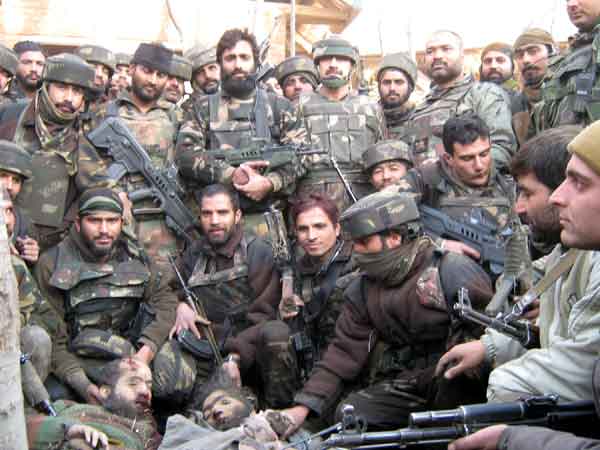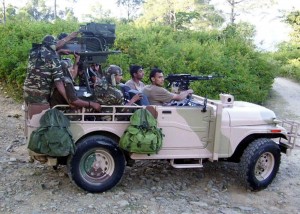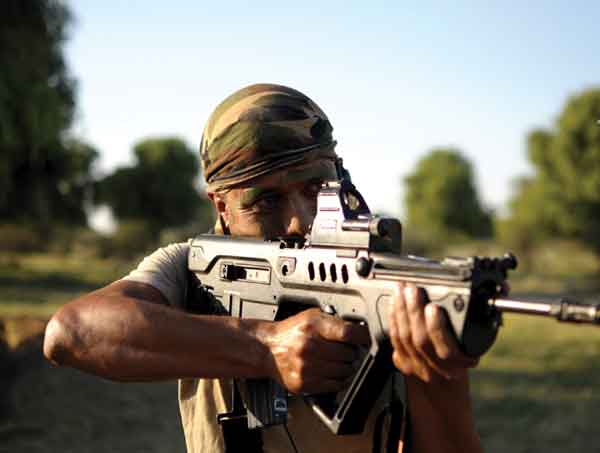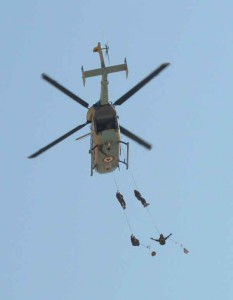Historically, Indian Special Forces have been used for direct action type of roles during conventional wars. The hierarchal understanding of trans-border employment of Special Forces in India is short distanced physical or direct type of actions executed on a unit/sub-unit basis to achieve battlefield victories. There is no concept of them being used abroad other than in conventional war. While Special Forces should be central to asymmetric response including against irregular forces, asymmetric warfare does not automatically equate to a physical attack. A physical attack is only the extreme and potentially most dangerous expression of asymmetric warfare. The key lies in achieving strategic objectives through application of modest resources with the essential psychological element.
Indian history is replete with examples of special missions – from the Cholas to the Mauryas, from Shivaji to Rana Pratap and Maharaja Ranjit Singh and many others. In the aftermath of the Chinese aggression of 1962, independent India saw the advent of the Special Forces with establishment of the Special Frontier Force (SFF) amply covered in the media including during the 1971 Indo-Pak War and the conflict in Kargil in 1999 . In the Army, the initiative of raising a commando unit was taken in 1965 by Major Megh Singh with the blessings of the then Western Army Commander.
Recently, the Naresh Chandra Committee recommended the establishment of a Special Forces Command…
Over the years, a host of Special Forces have come up in India. Special Forces get mentioned periodically as part of counter-insurgency/counter-terrorist operations or events such as the United States Special Forces (USSF) raid that killed Osama-bin-Laden; but little has happened in India to optimise their potential in furtherance of national security objectives. Recently, the Naresh Chandra Committee recommended the establishment of a Special Forces Command.
Nomenclature – Special Forces
The term ‘Special Forces’ is often misunderstood. The word “Special” should be sufficient to understand that such forces are to be employed primarily for strategic tasks beyond national borders. In his book ‘The Idea of Pakistan’, Stephen P Cohen writes “The task of Special Forces is the proxy application of force at low and precisely calculated levels, the objective being to achieve some political effect, not a battlefield victory.” This fundamental concept is ignored in India perhaps because we still do not have a National Security Strategy and have not defined our National Security Objectives, leave aside a national level Concept for Employment of Special Forces.
Ignorance and inability to grasp the strategic environment, its setting and compulsion under which such forces are employed, are evident. The impact of Special Forces operations is not well understood. Either their effects are overstated or fixated on tactical aspects of their missions. Keeping the military out of strategic decision making is one major reason.
Conflicts in the 21st Century
Warfare is no longer confined to the battlefield. Boundaries between war and no war are blurred by asymmetric wars that have no borders, no rules and no regulations. Psychological warfare imposes the largest penalty but affords the highest pay-offs. Successful psychological warfare demands integrated themes and subjects which need to be developed. In addition to causes of conflict such as territory, power and resources (water, energy and minerals) can become major flashpoints.
The impact of Special Forces operations is not well understood…
There is a heightened need for intelligence and deniable covert capabilities that ensure deniability of action for achieving strategic aims, both of which require the employment Special Forces. Transnational nature of threats and involvement of state actors in using sub-conventional conflicts have increased the complexity. Technology empowers terrorists to cause severe damage through cyber, financial and kinetic attacks. Acquisition of WMDs is a major concern. Asymmetric wars, of which terrorism and insurgencies are manifestations, will continue to dominate the conflict spectrum in the sub-continent albeit windows of conventional war under the NBC backdrop will remain.
Security Concerns
A two-and-half front war is a reality but the ‘half front’ can enlarge with China-Pakistan surreptitiously fanning insurgencies in India. China-sponsored Nepalese Maoists are linked with Indian Maoists. Also, China is pumping weapons through the Kachen rebels in Myanmar to insurgents in Manipur and Indian Maoists. A namesake democracy in Pakistan and increasing radicalisation plus Chinese presence in Pakistan/POK with China’s support to Pakistan’s anti-India jihadi policy will heighten the threat. Chinese stance on Arunachal and other Indian territories will, in all likelihood, harden with the capability gap widening exponentially between the PLA and Indian Military and the former getting more assertive.
The covert presence of Chinese Special Forces and intelligence agencies in Pakistan, POK, Nepal, Myanmar, Bangladesh, Sri Lanka as part of PLA construction companies is possible. The Chinese “String of Pearls” is being augmented with a “Ring of Islamic Radicalism” courtesy Pakistan’s LeT, latest target being Maldives. Elaborately established terror infrastructure in India by Pakistan over the years will make it more and more difficult to point a finger at the latter.
Growing inter-dependence and inter-linking of terrorist groups and insurgents pan-India and their international links, particularly Islamic radicals and heightened asymmetric war including cyber war, activation of cyberspace and electromagnetic domains should be serious concerns. India must also manage social change ably without which the youth will polarise towards terrorism/insurgency.
There is a heightened need for intelligence and deniable covert capabilities for achieving strategic aims…
The Need
Conflicts in recent years indicate that irregular/asymmetric forces have emerged with greater strategic value over conventional and even nuclear forces. We have failed to create deterrence against irregular forces relying only on diplomacy that by itself is not fully effective without integrating the military. Lack of strategic forethought has deterred us from exploiting the strategic potential of our Special Forces. India has suffered intelligence failures over decades. The recent discovery of some 11,000 Chinese in Pakistan/POK was courtesy the New York Times.
If we have Special Forces operatives covertly deployed in areas of our strategic interest, we will not be blind to future threats. The US discovered inadequacy of technical intelligence when Pokhran II surprised them completely. That is the reason they have operatives inside Iran for past several years. Covert Special Forces deployment in areas of strategic interest will significantly enhance our capacity to deal with multiple contingencies. There is urgent need to develop publicised overt capabilities and deniable covert capabilities as deterrence against the irregular war thrust upon us. Plus the will to selectively demonstrate it to ensure its effectiveness is needed. Our Special Forces potential must be optimised and exploited to develop such capability.
Special Forces in India
Wikipedia lists some 30 odd organisations as Special Forces of India, mostly police organisations but what could be considered as Special Forces actually are 8xArmy Special Forces battalions (two more are to be raised), MARCOS of the Navy (about 700 plus may eventually grow to 2,000, plus case for a Marine Brigade is pending with the government), Garuds of Air Force, 2xSpecial Groups (SGs) of SFF under the Cabinet Secretariat, the Aviation Research Centre (ARC) under the Cabinet Secretariat and 2xSpecial Action Groups (SAGs) of NSG under MHA (5,000 plus+ expansion of NSG is underway). These forces have hardly been strategically used for politico-military missions across the border.
Conceptually, Special Forces should be employed to continuously ‘shape the battlefield’…
Aside from routine UN missions, the only time India used Special Forces abroad was the three Special Forces units as part of the Indian Peace Keeping Force (IPKF) in Sri Lanka. The media often quotes parachute units as Special Forces, which is a misnomer. They are actually infantry battalions that have been trained for being delivered by parachutes. Upon landing, they operate as infantry battalions, holding ground till linked up. The combined strength of our Special Forces is around 20,000, much more than the uniformed strength of US Special Forces (currently 15,000) but not one tenth their capabilities. US SOCOM includes Psychological Operations and Civil Affairs Teams who are not uniformed personnel. With that strength, the USSF is deployed in 200 countries including India and we are milling around with a greater strength within our own country.
Concept
Historically, Indian Special Forces have been used for direct action type of roles during conventional wars. The hierarchal understanding of trans-border employment of Special Forces in India is short distanced physical or direct type of actions executed on a unit/sub-unit basis to achieve battlefield victories. There is no concept of them being used abroad other than in conventional war. While Special Forces should be central to asymmetric response including against irregular forces, asymmetric warfare does not automatically equate to a physical attack. A physical attack is only the extreme and potentially most dangerous expression of asymmetric warfare. The key lies in achieving strategic objectives through application of modest resources with the essential psychological element. They are ideally suited to control faultlines of the adversaries without any signatures or with ambiguous signatures.
Special Forces do not create resistance movements but advice, train and assist resistance movements already in existence. In asymmetric settings, Special Forces have limitless pro-active employment possibilities to exploit dissidence; employ asymmetric approaches from the NBC sphere to psychological operations, information war, economic/technical/ financial war. In counter-terrorism and counter-insurgency, Special Forces can be used for intelligence, surveillance and psychological operations, rival/pseudo gang operations, infiltrating tanzeems, neutralising terrorist leaders, organisations, support groups, infrastructure, selective raids, ambushes, snatch operations and incident response operations. In out-of-area contingencies, they can assist airborne/conventional forces or may be called upon to perform politico-military missions such as providing assistance to third world nations, surgical strikes, recovery missions, prevent terrorist use of WMDs and provide humanitarian assistance.
Special Forces cannot be mass produced and competent Special Forces cannot be created after emergencies arise…
Conceptually, Special Forces should be employed to continuously ‘shape the battlefield’ from conventional wars in nuclear backdrop to asymmetric and fourth generation wars. Their employment should be theatre/region specific and as force multipliers to complement tasks performed by conventional forces, entailing high risk, and high gain missions having minimum visibility with desired effect. Their strategic tasking should be in sync with national security objectives. Since tasking of Special Forces invariably includes Special Operations, Covert Operations and Special Missions, these itself provide the leeway to undertake virtually any strategic task.
Core tasks of foreign Special Forces are direct action, special reconnaissance, foreign internal defence, unconventional warfare, counterterrorism and counter-proliferation of WMDs, civil affairs operations, psychological operations and information operations. It is significant to note that the USSF also undertakes undeclared tasks such as conducting proactive, sustained “man hunt” and disruption operations globally, building partner capacity in relevant ground, air and maritime capabilities in scores of countries on a steady-state basis, helping generate persistent ground, air and maritime surveillance and strike coverage over “under-governed” areas and littoral zones, and employing unconventional warfare against state-sponsored terrorism and trans-national terrorist groups globally.
Additionally, in the Af-Pak region, the CIA had a 3,000-strong army of Counter Terrorism Pursuit Teams (CTPT) that have depleted in Pakistan post the Raymond Davies episode and the killing of Osama-bin-Laden.
Manning
Globally accepted Special Forces truths are – humans are more important than hardware; quality is better than quantity; Special Forces cannot be mass produced; and competent Special Forces cannot be created after emergencies arise. Regrettably, India has ignored these factors. Authorised expansion rate of SOCOM is 1.8 per cent annually though in 2011, this was hiked to 2.5 per cent in 2011, and now there is a bid for an addition of 3,000 which includes ‘support elements’ due to increased responsibilities.
Our Special Forces lack of quality manpower including officers…
Pakistan added the fourth SSG battalion only in recent years. India went in for a 120 per cent increase in the period 2001-2004 alone including converting three parachute battalions to Special Forces. The unprecedented expansion was resorted to by deliberately feeding the hierarchy that 20,000 USSF were operating in Iraq and Afghanistan, which was untrue since this included 82 and 101 AB Divisions of the US. Actually even in the peak period of USSF deployment only 90xOperation Detachments Alpha (ODAs) were actually used (each ODA is 10-12 strong). In terms of expansion, we are making the same mistake in the expansion of the NSG.
Our Special Forces lack quality manpower including officers and shortages are shared with rest of the military, which implies that the significance of Special Forces is little understood.
It is significant to note how seriously the USSF takes the issue of quality manpower. Take, for example, the personnel policies of the SEAL Team 6, which carried out the raid to kill Osama bin Laden. US Navy personnel volunteer for the SEALS and only those who make the cut are inducted. They serve in other SEAL teams for several years gaining operational experience.
Out of this lot, volunteers then opt for SEAL Team 6. It means they are truly the best of the best. Their average age profile is 32 years, which shows they have the right mix of youth and experience. This also underlines the seriousness with which the US develops their SF for various roles. The success of Op Neptune Spear is a testimony to that.
Equipping
Being under different chains of command, there is no commonality in equipment and no concept of ‘packaged equipping’, aside from Specialist/advanced training facilities being inadequate. Packaged equipment is essential because if a sub-unit does not have the complete authorised equipment, its combat capability will obviously be less.
The high level of sophisticated coordination and synergy to pull off Special Forces strategic missions is missing…
The equipment that is lacking presently is in terms of light-weight, hand-held laser target designators, information system package to communicate with required entities to include voice, data, video streaming, light-weight long-range global communications to call multiple weapon strikes, state-of-the-art listening and surveillance devices, from miniature devices hand-held to MAVs, helicopter transportable all terrain vehicles, corner shots, goggles/devices to see through walls, hand-held EW weapons, state-of-the-art explosive devices with long-term timers, all-terrain light-weight clothing and load carriage, latest survival equipment, to name a few.
Integration
India is perhaps the only country whose Special Forces have no centralised command structure. This, plus the lack of strategic culture and prolonged employment in counter-insurgency leaves little scope for specialisation. Resultantly, Army Special Forces are more ‘Jack of all Trades’. MARCOS have limited prowess on land, GARUD are sans specialised air transportation units and their tasking duplicates the tasks of the Army Special Forces.
Integrated and adequate intelligence is not institutionalised. Language training and proficiency is grossly inadequate. There is no concept of integrated or even dedicated air support. There is no concept of ‘support units’ including civilians. The SAGs of NSG and SGs of SFF are not cohesive units since 33 per cent of their manpower is turned over annually. Amongst the various Special Forces there is little or no joint training. The high level of sophisticated coordination and synergy necessary between various political, military, intelligence agencies and other departments to pull off Special Forces strategic missions is missing.
India is perhaps the only country whose Special Forces have no centralised command structure…
There is urgent need to educate and create macro conditions for Special Forces through measures such as creation of a national vision, joint doctrine, joint organisations and integrated intelligence support.
What India needs is Special Forces for strategic tasks including deterrence against irregular and asymmetric warfare, Commando Forces for cross-border tactical tasks and within border tasks beyond the capability of regular infantry and Airborne Forces for rapid reaction and force projection within and outside India.
To begin with, the Special Forces should be organised as a small 200 to 300 strong force with the highest regional specialisation, directly under the highest political authority since most politico-military missions would be without reference to the military because of the sensitive nature. Manpower should be drawn from existing Special Forces plus other all India avenues. They should be tasked with surveillance and target designation in areas of strategic interest, shaping asymmetric and conventional battlefield to Indian advantage, deterring opponents exploiting our faultlines, controlling faultlines of adversaries, undertaking information/psychological operations and unconventional warfare, anti-hijack, building partner capabilities with friendly countries and providing cutting edge for strategic force projection.
Warfare is no longer confined to the battlefield…
The balance of the Commando Forces should be reorganised into an Integrated Commando Command directly under the CDS/Permanent Chairman COSC, integrating the Army Special Forces, MARCOS, Garuds, NSG and the SFF.
Conclusion
There is an urgent need to create a deterrent against irregular and unconventional forces. Pro-active employment of Special Forces can help create such deterrence. While we may continue building military and political will, we must concurrently get on with building this capability.










I love my india
sir,i want join indian special force.plz can i join indian special force.plz information for the full details.specialy 9 para commando.
sir please help me.
Resp sir.
Sir, my age is 26 & i am doing computer oprator job in punjab,
Sir mai indian pera comando me jana chahta hu pr mujhe koi gidence nahi hai.
sir mera sapna hai ki mai is feeld mai jau. to sir please help me. please
sir,i want join indian special force.plz can i join indian special force
sir,i want join indian special force.plz can i join indian special force.plz information for the full details.specialy 9 para commando.
sir
i was really
happy by looking at the indian stf ifell to join and iam a cadet and a scout in my school
Sir i want to join the indian special forces.i want to who are eligible to special forces.
i want join indian special force.how can i join this please inform me full detials.
Sir I feelinig was join in army / special force ,can i join for army .pls information for the full details
It seems that the Indian is least bothered about protecting its strategic interests. Under the guise of covert ops the special forces are surgical tools to ensure protection of Indian strategic interests in cases where mere diplomacy fails. It is shocking to hear that a joint SF command does not even exist. Lets hope that the future sees some change.
The Author has rightly made out a strong case for Increasing the nos & the scope of the special forces..The Havoc that Special forces can do is best given in the 1962 indo-China war. The Chinese special forces bypassed the well entrenched 4 Div. & caused such a panic that the Whole of the Famous 4 Div. Disintegrated,Collapsed & took flight giving a bad reputation to the fighting skills of the Indian army..The Special forces need to be integrated in the fighting units at the mountain brigade level. The Mountain Strike corps should have a Brigade of special forces.Subsequently all strike corps should have one. There is a need for a special Forces Command also.
Lt. Katoch makes a strong point for India’s special forces. The Jihadi’s across the border are in essence a special force wing of the Pakistani military. That is why India is never able to prosecute in courts any of the real actors behind the horific terror violence from Pakistan. These groups carry out the mission of their radicalized army which is incapable of confronting India. To deal with such enemy India needs an ever expanding and evolving special forces to neutralize future attack. We need the best personnel, best equipment and the best training for such an outfit which should be ready to step into action 24/7 in any part of the country. India’s friends in the West, namely, US and Israel are the most experienced, resourced and intelligent about preventing terrorism. They should be solicited to help build a strong special force division as part of the Indian defence structure under a unified command.
Lt. General or General Katoch would be the correct form of address in this case. Major General is best addressed as Major General or simply General.General being the operative word. These are common mistakes made.
Lt. General Katoch indeed. Thank you for the correction.